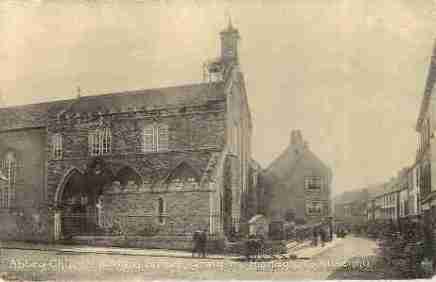
In 1278, Duiske Abbey in Graiguenamanagh bought out the land holding of David le Harpur at Coppenagh, in County Kilkenny. This photo shows the abbey church in the late 19th century. The church has been superbly restored since the photograph was taken.
Some years ago I discovered that there was an interesting document in the National Library of Ireland. This was a quit claim pertaining to a parcel of land in the townland of Coppenagh near the eastern edge of County Kilkenny, not far from the village of Graiguenamanagh. In fact the document even mentioned Graiguenamanagh in its guise as the Abbey of Duiske. The document noted that the man who signed it had inherited the land in question from his grandfather, Robert. The name of the man who issued the document was David le Harpur. The date was February 18th 1278 (hint, check your calendar!). Basically the document recorded the transfer of lands to the Cistercian Abbey of Duiske by David le Harpur and his landlord Raymond Roche. Sadly the original document from 1278 hasn’t survived, so National Library of Ireland manuscript D.287 is a sixteenth century copy of the original made for the Earl of Ormond, who was awarded the lands of Duiske at the Reformation. Ormond was clearly intent ion ensuring that no Harpur would ever reclaim the land at Coppenagh! What I love about this document is that it names David le Harpur and his grandfather, Robert – the original Anglo-Norman occupant of the land. Clearly Robert le Harpur must have come to Ireland in the year 1169 or very shortly thereafter. If we didn’t come on the first ship from Pembrokeshire, the Harpurs of Ireland surely came on the second one or third one! Sadly the passenger lists didn’t survive the centuries – if there ever were any. But at least we can look the FitzGeralds, Carews, Barrys in the eye as equals. We might even have been here before the Butlers – just! For some time I thought this particular document was the earliest documented reference to my family name in Ireland, but I was wrong.
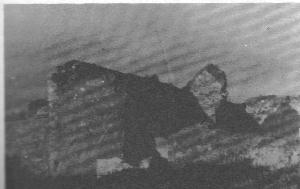
Twentieth century image of the ruins of Harperstown Castle in County Wexford – there’s even less to see now.
It seems we are linked to a ‘Sir William le Harper’ or Harpur who is sometimes described as Strongbow’s harper (well the surname had to come from somewhere!). Sir William was granted the lands of Aghdare which he, or a successor, renamed Harperstown. Aghdare means the ‘ford of the oaks’ – just like Adare in County Limerick! A later successor was David le Harpur who held three carucates of land in Aghdare in 1324. That’s a mere 360 acres – hardly a vast estate, but a comfortable landholding in the fourteenth century. Note how the name David keeps cropping up – a sure sign of Welsh origins, after all St David is the patron of Wales. Raise a toast to him on 1st March, his feast-day. There were extensive ruins of a castle and house at Harperstown in the later 19th century. There is some argument over whether that original Sir William le Harpur or a second man of the same name built the castle – suspicion must fall on the second fellow because the ‘castle’ was a tower house – a gentleman’s fortified mini castle, the equivalent of a small English manor house. Such buildings only come into being in Ireland, the north of England and Scotland from the mid-1300s. The main line of the Harperstown Harpurs ended in a daughter, Agatha, who married William Hore in 1336. She took the entire inheritance with her, so Harperstown in County Wexford was a chief seat of the Hore family for centuries thereafter (they had it until 1878!). At least the property went to another Anglo-Norman family, thanks to the Great Hore of the Harpurs! Happily, I can write about the family Hore without any shred of embarrassment. Although I have to confess that I feel that some of this story seems too good to be true. The fact that Aghdare townland was renamed Harperstown does suggest that at least one branch of the family were a cut above the rest as minor gentry.
I really should have issued a health warning in respect of the above tale of Sir William Harpur. The health specialists now tell us that all the stuff about avoiding salt is overstated – salt is good for us, so take the story of Sir William le Harpur with a good dose! The fact that great-great-great-great-great-etc.(ad infinitum!) aunt Agatha married William Hore in 1336 makes the tale of Harperstown Castle suspect. The Harpurs almost certainly had a house on the site, but I suspect the tower house was built by the Hores. So we can’t even claim credit for the castle, however ruinous! But we CAN claim to have given our name to a townland a few miles due south of Taghmon in County Wexford – Harperstown. This is bordered on the north east by the townland of Harveystown, on the east by Youngstown and on the south by Waddingstown! Harvey and Wadding are both grand old names from Wexford. There’s even a Horestown – which must make life interesting for the postman. On the first edition Ordnance Survey map it is clear that Harperstown is virtually a private demesne of the Hores, and is heavily planted with trees. Just north west in the townland of Augfad is a junction of five roads (one is actually the driveway into Harperstown House) called the Hand of Harperstown, presumably for a five-fingered sign-post that must have stood there.
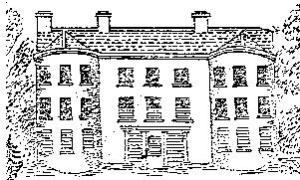
Sketch of Harperstown Castle – this is actually the country house erected by the Hore family who held the place much longer than the Harpurs.
Let’s tease out the Wexford links before dealing with the Ballinacorra Harpurs in County Cork. We know that the lands of Bargy and of Forth were granted to Robert FitzStephen and Maurice FitzGerald, to be held jointly (see my previous post). This suggests that the settlers from Wales and England were brought over by FitzStephen and his Carew heirs as well as FitzGerald. Now we know from my previous post on Ballinacorra that Robert FitzStephen was one of the two men given leave to conquer the kingdom of Cork in 1177 – and his lands there included Imokilly. FitzStephen’s heirs in Cork were the Carews – keep that fact in mind for the moment.
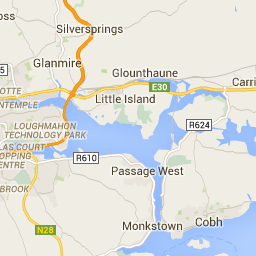
The main dual carriageway from Cork to Midleton crosses Harpers Island just to the right (east) of the green emblem indicating E30 – the official name of the road. The railway from Glounthaune to Fota crosses the island from north to south – Harpers Island only became busy in the late 20th century!
Now, I was long aware of the existence of Harpers Island in the inner reaches of Cork Harbour, lying between Fota Island and Glounthaune. I had assumed that this was linked to a family called Harper who had a house on Great Island in the later 1700s and early 1800s. They seem to have been later arrivals, probably Cromwellian or Williamite settlers – but that could be wrong. However, the Down Survey maps drawn up for the Cromwellian government shows the name in use by the 1650s. Clearly the island had the name since the middle of the 1600s, but does it go back further? At present I have no idea.
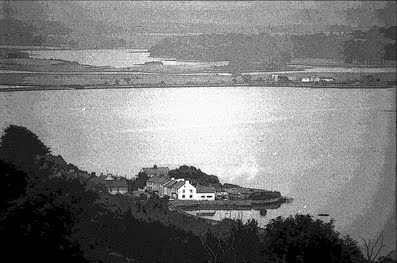
Harpers Island is the spit of land marking the upper edge of this body of water off Glounthaune (the village in the foreground). The island is utterly flat and even has reclaimed land – almost like a Dutch polder.
And yes, I know the spelling is different – Harper rather than my own Harpur. When I was learning to spell words in primary school, one of the first things I tried to do was write my own name. I wrote HARPER – which made a lot of sense to a five year old. But my mother corrected me – it was HARPUR. Which did not make sense to a five year old!.But she insisted so I stuck with it. In fact the spelling of the name did change over the centuries – le Harpour, le Harpeur, le Harpur, Harpur, Harper. My own line, and others from Wexford, preserved the HARPUR form. Another group of families with the name Harper moved into Ulster in the seventeeth century – they were Protestant planters. Among them were Harpurs from Scotland – a branch of the Buchanan family, and staunch Presbyterians. These families do not seem to be related to my bunch.
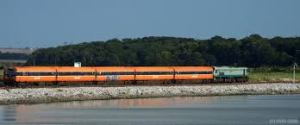
The train from Cork to Cobh crossing the causeway from Glounthaune onto Harpers Island. From there it proceeds to Fota which has its own station and then on to Cobh. Harpurs Island made the building of this railway much easier in the 19th century.
Paul MacCotter mentioned in his historical introductory essay in Jeremiah Falvey’s Chronicles of Midleton that the Harpurs were among the earliest Anglo-Norman settlers of Ballinacorra. I had a chance recently to ask him for further details – warts and all! And he kindly gave me the sordid details. You may recall from my previous post that many of the Anglo Norman settlers in Imokilly share names with Anglo-Norman settlers in south County Wexford. Clearly there are family relationships at work here – after all, the Carews, FitzGeralds, Barrys and others were all related. The Anglo-Norman ‘invasion’ of Ireland was a family enterprise. The overall leader, Richard FitzGilbert de Clare, Lord of Striguil, known as Strongbow, was the odd one out being barely related to the rest of the party, if at all.
So my suspicions are raised by the FitzStephan/Carew links between Bargy and Forth in Wexford and Imokilly in Cork. Bear in mind that, at this early stage, the FitzGeralds also had a short-lived foothold in Imokilly. But the Harpurs identified in Ballinacorra by Paul MacCotter were also settled on Carew lands.
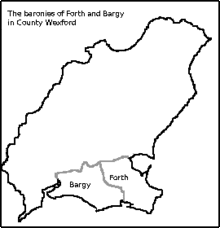
The baronies of Bargy and Forth in south Wexford were shared between Robert FitzStephen and Maurice FitzGerald. FitzStephen’s share was inherited by the Carews. The Harpurs were settled in Bargy in the century following the Anglo-Norman arrival in 1169. The links between this area and Imokilly were very strong – because FitzStephen took Imokilly from the local Irish lords. The Carews probably settled people from Bargy and Forth in Imokilly.
The earliest reference for the Ballinacorra Harpurs is 1260, when Henry le Harpur was impleaded by Richard de Carew for 14 acres in the vill of Castle Corth. Basically Henry Harpur was arguing with his landlord over possession of 14 acres in Ballinacorra, and the landlord took him to court. It is not certain if the Richard de Carew named here was the son or grandson of the Richard de Carew who bought the manor of Castle Corth/Ballinacorra from Thomas des Autres in the 1190s.
The second mention is more sordid. John, son of Theobald le Harpur, was accused of violent disseisin with members of the Cod family at Ardraha near Cloyne in 1295. There was a row between John le Harpur and the Cods of Cloyne – and violence was used, or threatened. I wonder if it was over land? That could cause a row!
The last mention is from 1336 – now that’s an interesting date because it is shortly before Thomas de Carew sold Castle Corth or Ballinacorra to William de Barry. There is simply a mention of a David le Harpur residing at Castle Corth – he’s probably a burgess or townsman, a tenant of the estate, with a small plot of land.
There seems to be no further reference to the Harpurs of Ballinacorra after that – perhaps the Black Death finished them off in 1348. But note the year 1336 – this was also the fateful year in which Agatha Harpur of Harperstown in Wexford married William Hore. It’s been downhill since.
There’s more research to be done here, but one thing is clear – the Harpurs of Ballinacorra must have been settled in Imokilly after 1220 by the Carews. And they probably came from County Wexford – just like my father’s family. No wonder I feel so much at home here in Midleton! Now if only we can reclaim Harperstown….or maybe Harpers Island. I fear asking for the return of Coppenagh might be too much to hope for (sigh).
Many thanks to Paul MacCotter for the information on the Harpurs of Ballinacurra given above!
Link to an online article on Harperstown and the supposed origins of the Harpurs of Wexford. (Take a dose of salt before reading this):